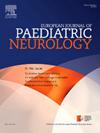Spinal cord stimulation (SCS) induced favorable neuromodulative outcome in the treatment of chronic neuropathic pain syndrome in children
IF 2.3
3区 医学
Q3 CLINICAL NEUROLOGY
引用次数: 0
Abstract
Background
Chronic pharmaco-resistant pain syndrome (CPS) requires different therapeutic approaches based on the underlying pathology. Spinal cord stimulation (SCS) in children with chronic neuropathic pain syndrome (CNPS) has been scarcely reported in the literature.
Objectives
To present SCS as the rational treatment approach in children with chronic regional and generalized chronic neuropathic pain syndrome, its efficiency, complications and the role in neuromodulation.
We present two children with chronic pain syndrome treated with SCS. A 14-year-old girl at the age of 8 manifested with signs of chronic regional pain syndrome (CRPS) type 1 in wrist and afterwards in knee, associated with allodynia, signs of local autonomic dysfunction, trophic changes of the skin, and loss of ambulation. Nerve biopsy showed inflammatory infiltrates and loss of small unmyelinated C in skin biopsy.
A 17-year-old boy manifested at the age of 9 with clinical signs of acute central (CNS) and peripheral nervous system (PNS) involvement associated with headache, photophobia, ataxia, paraparesis, autonomic dysfunction and intensive generalized global neuropathic pain, especially in the lower extremities. Electromyoneurography (EMNG) at the first exam was compatible with Guillain Barre syndrome and subsequently several times during follow up EMNG and nerve biopsy were compatible with chronic inflammatory demyelinating polyneuropathy (CIDP). Treatment was maintained with i.v. immunoglobulins (IVIG) and steroids without functional improvement.
In both children functional psychosomatic, orthopedic and rheumatologic causes were excluded including painful genetic neuropathies. Seven and eight years after the onset of symptoms and signs of CPS in both children, epidural SCS was implanted, followed by pain relief up to 100 % with complete recovery of motor function, local skin changes and of intraepidermal nerve fiber density in a girl. A boy became ambulant, 50 % up to 75 % pain control was attained, and only partial recovery of sphincter control.
Conclusion
SCS as minimally invasive neurosurgical method may be efficient in resolving chronic pain and in restoring functional abilities of affected extremities. SCS should be considered as a treatment approach in children with chronic regional and generalized (pharmacoresistant) neuropathic pain syndrome resistant to all established treatment modalities.
脊髓刺激(SCS)在儿童慢性神经性疼痛综合征的治疗中诱导了良好的神经调节结果
背景:慢性药物抵抗性疼痛综合征(CPS)需要基于潜在病理的不同治疗方法。脊髓刺激(SCS)治疗儿童慢性神经性疼痛综合征(CNPS)的文献报道甚少。目的探讨SCS作为儿童慢性区域性和全身性慢性神经性疼痛综合征的合理治疗方法,探讨其疗效、并发症及在神经调节中的作用。我们报告了两例用SCS治疗慢性疼痛综合征的儿童。一名14岁女孩,8岁时表现为手腕和膝盖的慢性区域疼痛综合征(CRPS) 1型体征,并伴有异常性疼痛、局部自主神经功能障碍、皮肤营养改变和行走能力丧失。神经活检显示炎症浸润,皮肤活检显示小无髓鞘C丢失。一名17岁男孩在9岁时表现出急性中枢(CNS)和周围神经系统(PNS)受累的临床症状,伴有头痛、畏光、共济失调、麻痹、自主神经功能障碍和强烈的全身性神经性疼痛,特别是在下肢。第一次检查时肌电神经图(EMNG)与格林-巴雷综合征相符,随后随访时多次EMNG和神经活检与慢性炎症性脱髓鞘性多神经病变(CIDP)相符。继续静脉注射免疫球蛋白(IVIG)和类固醇治疗,未见功能改善。在两名儿童中,排除了功能性心身、骨科和风湿病原因,包括疼痛性遗传神经病。在两名儿童出现CPS症状和体征的7年和8年后,硬膜外SCS植入,随后疼痛缓解达100%,运动功能完全恢复,局部皮肤改变,表皮内神经纤维密度恢复。一个男孩开始走动,50%到75%的疼痛得到了控制,括约肌控制只有部分恢复。结论scs作为一种微创神经外科方法,可有效缓解慢性疼痛,恢复患肢功能。SCS应被视为对所有现有治疗方式都有抵抗力的儿童慢性区域性和全身性(耐药)神经性疼痛综合征的治疗方法。
本文章由计算机程序翻译,如有差异,请以英文原文为准。
求助全文
约1分钟内获得全文
求助全文
来源期刊
CiteScore
6.30
自引率
3.20%
发文量
115
审稿时长
81 days
期刊介绍:
The European Journal of Paediatric Neurology is the Official Journal of the European Paediatric Neurology Society, successor to the long-established European Federation of Child Neurology Societies.
Under the guidance of a prestigious International editorial board, this multi-disciplinary journal publishes exciting clinical and experimental research in this rapidly expanding field. High quality papers written by leading experts encompass all the major diseases including epilepsy, movement disorders, neuromuscular disorders, neurodegenerative disorders and intellectual disability.
Other exciting highlights include articles on brain imaging and neonatal neurology, and the publication of regularly updated tables relating to the main groups of disorders.

 求助内容:
求助内容: 应助结果提醒方式:
应助结果提醒方式:


